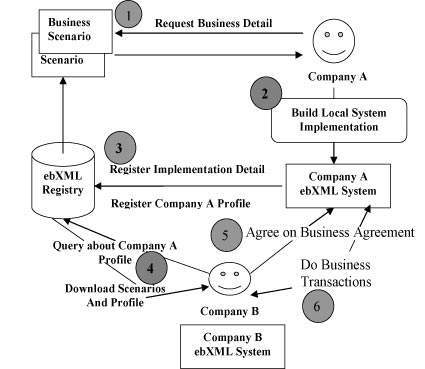
- ebXML - Home
- ebXML - Introduction
- ebXML - Architecture
- ebXML - Business Process
- ebXML - CPP & CPA
- ebXML - Registry Service
- ebXML - Core Components
- ebXML - Messaging Service
- ebXML - Usage Example
- ebXML - Summary
- ebXML Useful Resources
- ebXML - Quick Guide
- ebXML - Useful Resources
- ebXML - Discussion
ebXML - Usage Example
The following diagram shows an ebXML scenario, which makes it easy to pick up the concept of ebXML. The example is taken from the Technical Architecture Specification.

The example shows how organizations prepare for ebXML, search for new trading partners and then engage in electronic business.
Company A browses the ebXML registry to see what is available online. At best, company A can reuse all the existing business processes, documents, and core components common to its industry that are already stored in the ebXML registry. Otherwise, company A designs the missing parts, stores them in the ebXML registry and makes them available for its industry partners.
Company A decides to do electronic business the ebXML way and considers implementing a local ebXML compliant application. An ebXML Business Service Interface (BSI) provides the link between the company and the outside ebXML world. The company has to create a Collaboration Protocol Profile (CPP) which describes the supported business process capabilities, constraints and technical ebXML information such as choice of encryption algorithms, encryption certificates, and choice of transport protocols.
Company A submits its CPP to ebXML registry. From that point on, company A is publicly listed in the ebXML registry and is likely to be discovered by other companies querying for new trading partners.
Company B is already registered at the ebXML registry and is looking for new trading partners. Company B queries the ebXML registry and receives the CPP of company A. Company B then has two CPP's: Company A's CPP and its own. The two companies have to come to an agreement on how to do business, which is called a Collaboration Protocol Agreement (CPA) in the ebXML terminology. Company B uses an ebXML CPA formation tool to derive a CPA from the requirements of the two CPPs
In this scenario, company B communicates with company A directly and sends the newly created CPA for acceptance to company A. Upon agreement of the CPA by company A, both companies are ready for electronic business.
The companies then use the underlying ebXML framework and exchange business documents conforming to the CPA. This means that both companies follow the business processes defined in the CPA.